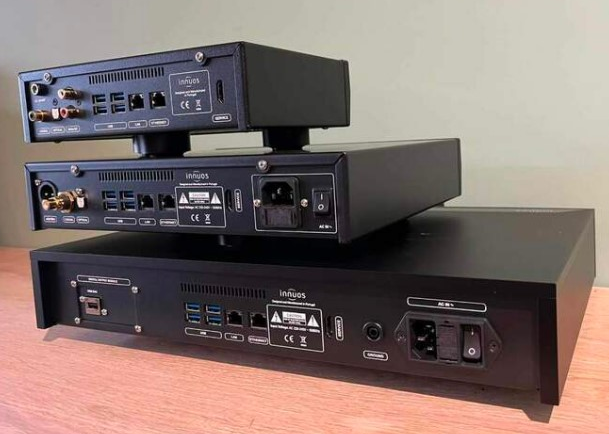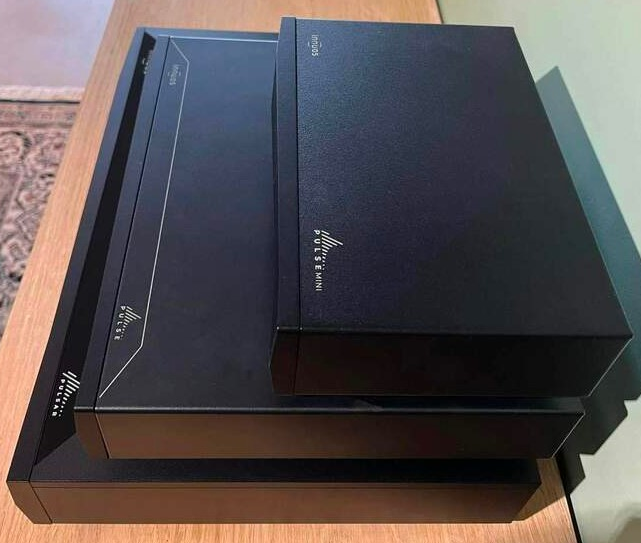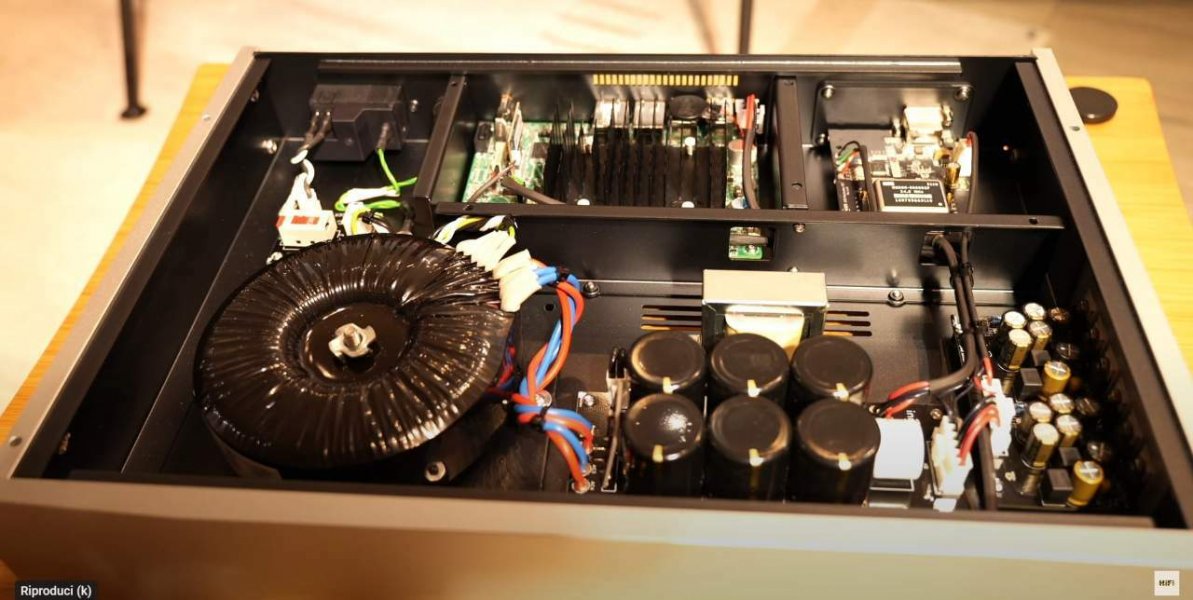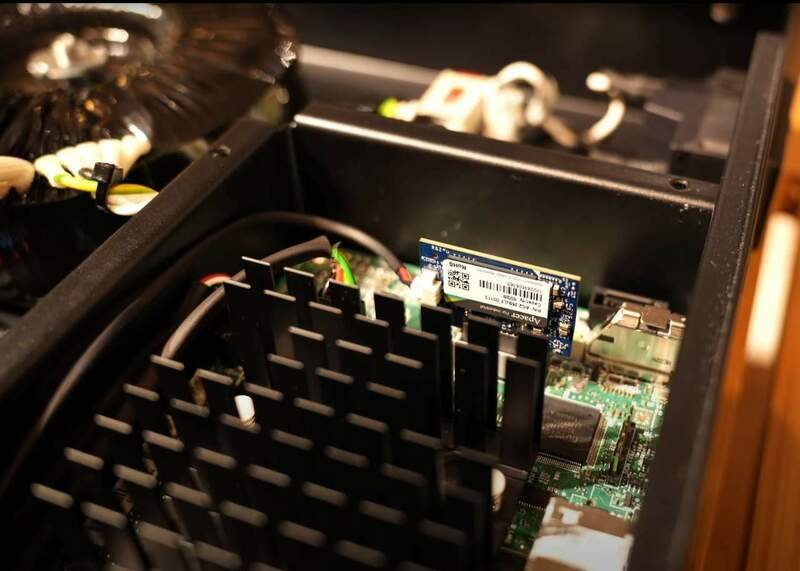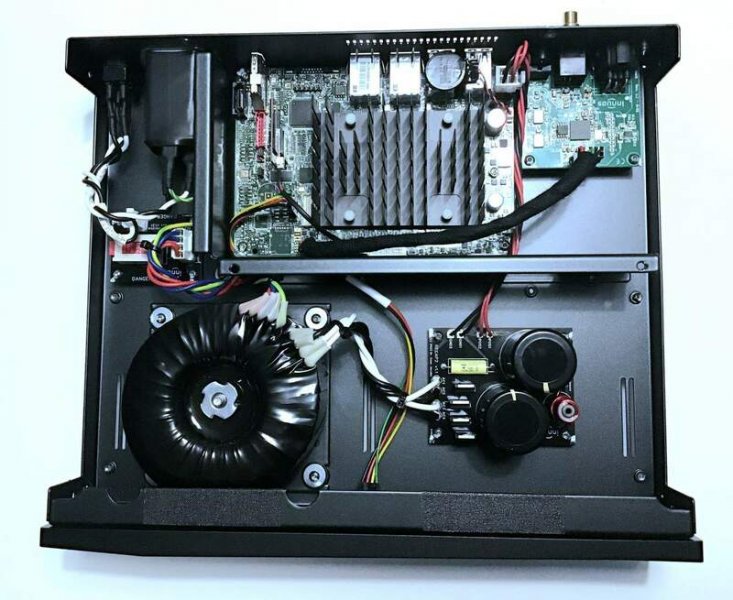Yes, just @tedwoods please provide info about your NAS and power cords of NAS when you will be ready to share your findings.That would be great, I'm sure others too would be interested in the results!
Innuos Pulsar ????
- Thread starter jadedavid
- Start date
You are using an out of date browser. It may not display this or other websites correctly.
You should upgrade or use an alternative browser.
You should upgrade or use an alternative browser.
+1At least they could implement regular Phoenix USB.
I am wondering about the price difference with a regular Phoenix USB implemented from the start.
Interesting also post #42
Matt
Last edited:
I recently purchased a Pulsar specifically to stream music from my NAS. It is advertised as having the capability to play 24bit/768KHz files for this purpose. Since I use PGGB to upsample my music to this resolution, it was a key selling point. Prior to purchase, I contacted Innuos directly, and they confirmed the ability of the Pulsar to output this resolution.
I have found the Pulsar will not play 24bit/768KHz WAV files created by either PGGB or HQPlayer Pro in standalone mode using the Innuos Sense app. It appears the Pulsar is not capable of playing this resolution except when using a Roon or HQPlayer server with the Pulsar in endpoint mode. This fine point is not clearly stated on the Innuos website, nor was it mentioned in their pre-sale email response to me. If you are someone who listens to upsampled music, be aware of this limitation.
I have found the Pulsar will not play 24bit/768KHz WAV files created by either PGGB or HQPlayer Pro in standalone mode using the Innuos Sense app. It appears the Pulsar is not capable of playing this resolution except when using a Roon or HQPlayer server with the Pulsar in endpoint mode. This fine point is not clearly stated on the Innuos website, nor was it mentioned in their pre-sale email response to me. If you are someone who listens to upsampled music, be aware of this limitation.
Interesting @MusicListener .which sounds great but for a little more money and a big increase in SQ power a Pulse mini with a Sean Jacobs mini DC4 ARC6 LPS and output to the Phoenix USB.
Did you try and compare for a day? You ended up purchasing the latter?
like this?
USD$ 6899 I tried the Pulsar (w/o Phoenix USB)
vs.
USD$ 1249 : Pulse mini
USD$
USD$ 3749 : Phoenix USB
Total: USD$
Last edited:
Very disappointing indeed.I recently purchased a Pulsar specifically to stream music from my NAS. It is advertised as having the capability to play 24bit/768KHz files for this purpose. Since I use PGGB to upsample my music to this resolution, it was a key selling point. Prior to purchase, I contacted Innuos directly, and they confirmed the ability of the Pulsar to output this resolution.
I have found the Pulsar will not play 24bit/768KHz WAV files created by either PGGB or HQPlayer Pro in standalone mode using the Innuos Sense app. It appears the Pulsar is not capable of playing this resolution except when using a Roon or HQPlayer server with the Pulsar in endpoint mode. This fine point is not clearly stated on the Innuos website, nor was it mentioned in their pre-sale email response to me. If you are someone who listens to upsampled music, be aware of this limitation.
PULSAR Standalone vs. Endpoint mode
Did you, or anyone else, compare the PULSAR Standalone mode vs. the Endpoint mode? I would assume for better SQ the latter is preferred.
PULSAR no internal SSD (local files) vs Streaming
PULSAR can not play local files, that by a majority are still regarded as sounding better than streamed files.
Did someone hear that to be a disadvantage compared to (previous INNUOS) streamers who do have local SSD?
Since PULSAR can only stream, and to compensate for a potential SQ loss (if) , does adding something like a PHOENIXnet improve SQ? Or did the internals take care of eliminating that SQ difference?
Last edited:
I was able to try the Pulsar in my system for a long weekend. Went with the latter as in my mind the PhoenixUSB was a must have and the SJ DC4 is specd way better than the Pulsar.Interesting @MusicListener .
Did you try and compare for a day? You ended up purchasing the latter?
like this?
USD$ 6899 I tried the Pulsar (w/o Phoenix USB)
vs.
USD$ 1249 Pulse mini
USD$ 5400 with a Sean Jacobs mini DC4 ARC6 LPS
USD$ 3749 and output to the Phoenix USB
USD$ 10.398 + USD$ ?? cables
By the way, SJ DC4 is listed at USD4,000I was able to try the Pulsar in my system for a long weekend. Went with the latter as in my mind the PhoenixUSB was a must have and the SJ DC4 is specd way better than the Pulsar.
Thanks. And nice to be able to compare both at home!By the way, SJ DC4 is listed at USD4,000
Correct. I mistakenly quoted the standard version arc6 DC4. The difference is now US$2000 (corrected above ;-). That makes more sense.
Did you compare/listen to PULSEmini vs. PULSAR with each streaming from a music service? Or, a likely improvement in SQ : music playing from a dedicated audio server and each in their
Is it possible that the Pulse/mini and Pulsar perform optimally as
Additionally, I'm curious if combining a Phoenix USB with the ZEN/ith series could achieve a performance level similar to their counterparts in the Pulse series, with the exception of the Statement (with or without arc upgrade), which is expected to remain the best performer among them all.
- - -
images: melius.club/topic/9553-innuos-pulse-series
Attachments
Last edited:
Quobuz and files played from a roon NUC server over fibre optic network.Thanks. And nice to be able to compare both at home!
Correct. I mistakenly quoted the standard version arc6 DC4. The difference is now US$2000 (corrected above ;-). That makes more sense.
Did you compare/listen to PULSEmini vs. PULSAR with each streaming from a music service? Or, a likely improvement in SQ : music playing from a dedicated audio server and each in their standalone mode?
Is it possible that the Pulse/mini and Pulsar perform optimally as standalone endpoints in any output mode, while the ZEN/ith series can excel at least at the same SQ level in both standalone and endpoint mode?
Additionally, I'm curious if combining a Phoenix USB with the ZEN/ith series could achieve a performance level similar to their counterparts in the Pulse series, with the exception of the Statement (with or without arc upgrade), which is expected to remain the best performer among them all.
- - -
images: melius.club/topic/9553-innuos-pulse-series
What I was describing as a “mess“ was the sound from the Phoenix Lite (reclocked DAC output)Hi Vangelis, maybe I am understanding something wrong in your post. At the start you mention that adding the Phoenix USB 'makes a mess of the music.' Then after you mention that for the best sound, you still need to have the Phoenix in the chain?
from the Pulsar connected to the PhoenixUSB, essentially, reclocking twice. The music line completely falls apart when reclocked twice. The Pulsar sounds clearly better connecting to PhoenixUSB from one of its center bank (non-reclocked) outpts instead of the (DAC output) reclocked Phoenix Lite output.
The developer of PGGB, ZB, suggested that I use HQPlayer to serve PGGB 16fs files to the Pulsar since the Innuos app is unable to stream them natively in standalone mode. He felt using an ordinary, unoptimized laptop running on battery, or even a desktop PC, as an HQPlayer server for 16fs files would be superior to 8fs files streamed natively by the Pulsar. I am pleased to report he was 100% correct. I believe this outcome is a huge testament to the value of using PGGB to upsample music.
I also have a Zenith MkII SE. Would you say that I would be better off getting a PhoenixUSB than replacing the Zenith SE with the Pulsar? Strictly in terms of SQ.This my experience regarding the Pulsar. The Pulsar sounds good. Does it sound better than my old limited edition $7K Zenth MKII? The Pulsar is a bit bolder, with more meat on the bones and authority. That being said, I was given the impression last fall that the onboard Phoenix light within the Pulsar should provide most of the benefit that already existed from my PhoenixUSB and that I wouldn't likely need to continue to keep my PhoenixUSB. There was speculation that adding the Phoenix USB, to the output of the Phoenix light, would actually make it sound worse, and this turned out to be correct, the Phoenix lite output the PhoenixUSB just makes a mess of the music. In A/B comparison between the outputs PhoenixUSB and Phoenix light, the difference was immediately obvious. Unfortunately, the PhoenixUSB continues to absolutely required to realize the best Innuos sound, at least from my Pulsar and Zenith Special Edition. The presentation from the PhoenixUSB is still way more compelling than Phoenix lite, with a greater rhythmic pace, clarity and an unwrapping of the harmonics that just makes the music more understandable and engaging. I was really hoping to simplify my front end, and ditch my PhoenixUSB, the second USB cable and a power cord, the dollar math is not very attractive.
I have the same question and I understand:I also have a Zenith MkII SE. Would you say that I would be better off getting a PhoenixUSB than replacing the Zenith SE with the Pulsar? Strictly in terms of SQ.
So based upon above, it seems to me, for best SQ your MKII SE will benefit more with a PhoenixUSB added compared to a Pulsar without. Fortunately that seems a more economical solution in your situation.Unfortunately, the PhoenixUSB continues to absolutely required to realize the best Innuos sound, at least from my (editPulsar and)Zenith Special Edition.
It seems you also have to take in consideration if you play local files/from a NAS vs. streaming, and possibly a better AC cable/fuse/USB cable for the PhoenixUSB. Any suggestions someone maybe?
just added;
The potential weaknesses of the present-day very good sounding Zeniths (5 years old?) lie in their operating system situated on consumer grade SSDs (as opposed to the SLC Apacer industrial SSD utilized in Pulsar), as well as the relatively inferior quality of the RAM—lacking wide temperature/industrial specifications. Additionally, the older motherboard generates more heat and noise. I'm curious about the Pulsar's RAM capacity and its placement on the recent MOBO.
That being said, the energy-efficient 2023 Pulsar outperforms in terms of a higher quality power supply unit, regulators, and inductors (resulting in a blacker background/instrument separation). It employs a single LPS for USB compared to the PhoenixUSB's two, which likely contributes to the observed differences in sound quality. It's worth noting that the current USB output can be substituted in the future to accommodate alternative outputs. Considering these factors, it wouldn't be surprising to see an increase in positive Pulsar reviews this year.
Last edited:
Interestingly, I didn't find changing the power cable on the PhoenixUSB made a big difference but good USB cables are very impactful.I have the same question and I understand:
So based upon above, it seems to me, for best SQ your MKII SE will benefit more with a PhoenixUSB added compared to a Pulsar without. Fortunately that seems a more economical solution in your situation.
It seems you also have to take in consideration if you play local files/from a NAS vs. streaming, and possibly a better AC cable/fuse/USB cable for the PhoenixUSB. Any suggestions someone maybe?
excellent information!I have the same question and I understand:
So based upon above, it seems to me, for best SQ your MKII SE will benefit more with a PhoenixUSB added compared to a Pulsar without. Fortunately that seems a more economical solution in your situation.
It seems you also have to take in consideration if you play local files/from a NAS vs. streaming, and possibly a better AC cable/fuse/USB cable for the PhoenixUSB. Any suggestions someone maybe?
just added;
The potential vulnerabilities of the present-day Zeniths (around 2016-17) lie in their operating system situated on outdated SSDs (as opposed to the SLC Apacer industrial SSD utilized in Pulsar), as well as the relatively inferior quality of the RAM—lacking wide temperature/industrial specifications. Additionally, the older motherboard generates more heat and noise. I'm curious about the Pulsar's RAM capacity and its placement.
That being said, the energy-efficient 2023 Pulsar outperforms in terms of a higher quality power supply unit, regulators, and inductors (resulting in a blacker background/instrument separation). It employs a single LPS for USB compared to the PhoenixUSB's two, which likely contributes to the observed differences in sound quality. It's worth noting that the current USB output can be substituted in the future to accommodate alternative outputs. Considering these factors, it wouldn't be surprising to see an increase in positive Pulsar reviews this year.
Pulsar Upgrade
Pros: newer hardware tech, longer time before obsolescence
Cons: minimal SQ increase
Adding PhoenixUSB
Pros: increased SQ
Cons: additional box, power chord, usb chord, sticking with older streamer/server tech.
Regarding sound quality (SQ), I anticipate further reviews. Nuno suggests that the Pulsar's SQ should be 10%-20% lower than that of an Innuos Statement, which is a rather bold assertion taking it's price point in consideration (even more so when SQ is closer to 90% of a Statement).excellent information!
Pulsar Upgrade
Pros: newer hardware tech, longer time before obsolescence
Cons: minimal SQ increase
Adding PhoenixUSB
Pros: increased SQ
Cons: additional box, power chord, usb chord, sticking with older streamer/server tech.
Also, before judging SQ, take into account your listening preferences:
- Do you prefer local files or streaming? (The Pulsar lacks a local files option)
- As demonstrated earlier, certain files like PGGB WAV need processing on a main music server before being sent to the Pulsar in Endpoint mode.
- It's worth noting that employing any Innuos device in Standalone mode versus Endpoint mode doesn't produce equivalent sound quality (YMMV of course).
Last edited:
those are definitely some bold claims! When the time comes, I will have to get the Pulsar in house and a/b as I use the MkII SE in standalone mode primarily.Regarding sound quality (SQ), I anticipate further reviews. Nuno suggests that the Pulsar's SQ should be 10%-20% lower than that of an Innuos Statement, which is a rather bold assertion taking it's price point in consideration (even more so when SQ is closer to 90% of a Statement).
Also, before judging SQ, take into account your listening preferences:
To me Pulsar seems more geared to internet streaming in Standalone mode and if that's exclusively how you intend to use it maybe even a (mini)Pulse could be sufficient.
- Do you prefer local files or streaming? (The Pulsar lacks a local files option)
- As demonstrated earlier, certain files like PGGB WAV need processing on a main music server before being sent to the Pulsar in Endpoint mode.
- It's worth noting that employing any Innuos device in Standalone mode versus Endpoint mode doesn't produce equivalent sound quality (YMMV of course).
So I would agree my Zenth MKIIse with the PhoenixUSB (PN) clearly sounds better then the Pulsar without a PN. The PN fleshes out far more music density within the soundstage envelope. There just is a lot more going on from the musicians, and the music makes more sense, sometimes more musicians become more apparently within the mix. Without the PN, I was listening to a song, and it sounded like an acoustic guitar with perhaps some effects or reverb, trailing it. When I installed the PN, I could clearly hear that there were actually two guitars, playing in perfect pitch and harmony, and in tune with each other it was the same level of improvement (but not necessarily the exact same sound) adding the PN to either Innuos. This is about musical clarity and engagement. The PN, at least in my system also improved with the addition of a SR Purple fuse, and an upgraded power cord and the use of a second, same high-quality USB cable in the signal path. Unfortunately, on the PN side, the costs do add up. But also viewing from cost standpoint, if you have to add a outboard or server or NAS to play your files plus an additional upgraded power cord, Ethernet cable and possibly an upgraded power supply, that makes a pretty good case for a Zenith with everything in one chassis. I am not advocating for buying a five year old Zenth MKIIse, this is just my personal experience.
Similar threads
- Replies
- 19
- Views
- 546
- Replies
- 28
- Views
- 3K
- Replies
- 1
- Views
- 130
- Replies
- 4
- Views
- 3K
| Steve Williams Site Founder | Site Owner | Administrator | Ron Resnick Site Owner | Administrator | Julian (The Fixer) Website Build | Marketing Managersing |












